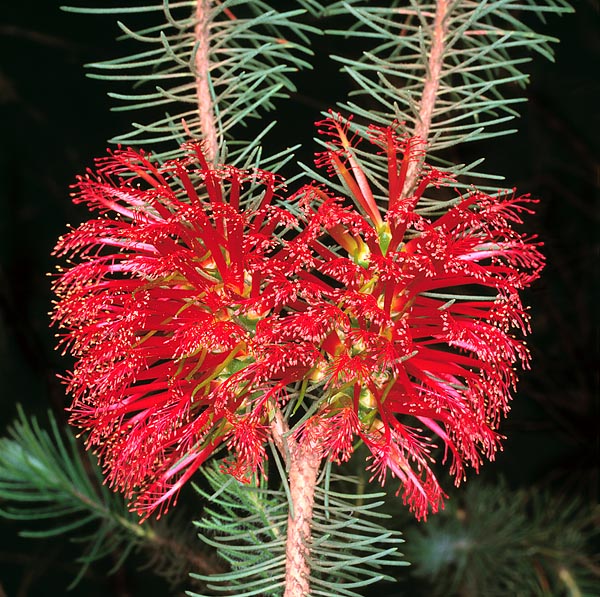Family : Myrtaceae

Text © Pietro Puccio

English translation by Mario Beltramini
This species is native to south-western Australia (Western Australia), where is widely diffused. It lives on sandy, stony soil or on granite outcrops, in zones characterized by a Mediterranean-type climate, with humid and mild winters and warm and dry summers, with frequent fires which contribute to renew the vegetation.
The name of the genus is the combination of the Greek terms “kalós” = beautiful, and “thamnos” = shrub; the Latin name of the species, “quadrifidus” = divided into four parts, refers to the number of the parts (sepals, petals and bundles of the stamina), in which the flower is divided. Common names: crimson cluster net-bush, crimson netbush, one-sided bottlebrush (English).
The Calothamnus quadrifidus R.Br. ex W.T.Aiton (1812) is a rather variable, evergreen shrub, with erect or prostrate posture, much ramified, 1-3 m tall, with thin linear leaves, 2-4 cm long, of green or green grey colour, covered, at times, by a slight down, aromatic.

Calothamnus quadrifidus. Seems a pine, but the flowers remove all doubts © Giuseppe Mazza
The inflorescences are spikes with herma- phrodite, rich in nectar, flowers often lined on one side of the 1-2 years old branches, with four greenish sepals, about 0,5 cm long, four little longer petals and the stamina, the most evident part of the flowers, united at the base in four 2,5 cm long bands, of an usually bright red colour, less frequently yellow and white; the pollination is done by nectarivorous birds.
The fruits are globous capsules, of 0,5 cm of diameter, woody, persistent for several years, containing numerous tiny seeds. It easily reproduces by seed, placed in surface on sandy soil, and kept humid, which germinated in 3 to 4 weeks and by tip cutting in summer.
It is a fast growing species appreciated, in addition to its abundant and long lasting flowering and the delicate foliage, also for the facility of cultivation and adaptability to different typologies and conditions of soil.
It grows on sandy and stony as well as on clayey, soils, from lightly acidic to alkaline; when well rooted, it resists to long drought periods, but it adapts also to humid soils provided the same are perfectly draining; it also resists to the saline aerosols and therefore it can be utilized in coastal zones.
It is cultivable in full sun or slight shade in the zones with tropical, subtropical climate and in warm temperate ones, where it can resist to temperatures to about -4 °C, or little less, when adult and for a very short time.
It can be used as isolated specimen or in group, as soil cover, in particular the dwarf varieties and with prostrate posture and for fences; periodical prunings are useful, after the blooming, for maintaining a compact appearance; the cut brunches are often utilized in the floral compositions.
It is one of the most utilized species in its origin places in the revegetation programmes.
Synonyms: Beaufortia pinifolia Cels (1817); Billottia acerosa Colla (1824); Melaleuca acerosa (Colla) Sweet ex G.Don (1832); Calothamnus clavatus J.Mackay ex Schauer (1845); Calothamnus laevigatus Schauer (1845).
→ To appreciate the biodiversity within MYRTACEAE family please click here.
